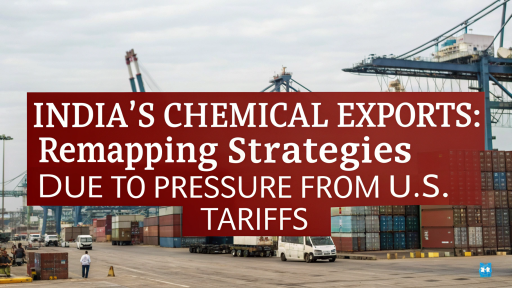India is experiencing swift industrial growth along with increased opportunities in agro chemicals, pharmaceuticals, textiles, and other manufacturing sectors. This makes India an attractive place for bulk chemical trading. The bulk and technical-grade chemicals urea, acetone, and formic acid have several industrial uses. Unlike fine or specialty chemicals which require labor-intensive R&D and patented technology, these technical-grade chemicals are standardized commodities, which lowers the barrier to entry for startups and MSMEs.
With growing domestic demand as well as a dependence on imports and government-led initiatives toward industrialization, there is opportunity in bulk chemical trading with low-to-medium risk and high volume potential. Such a business model enables entrepreneurs to bypass complicated structures like manufacturing units while operating through profit-heavy logistics optimization, storage arbitrage, and wholesale distribution.
In this guide I outline the steps to start your own bulk trading business in India using three focus chemicals that have high demand; technical-grade urea, acetone, and formic acid. We will cover the entire scope of business ranging from importance of market dynamics and pricing trends to sourcing strategies alongside operational setup along with gauging their feasibility all customized for novice industrial entrepreneurs.
Why Technical-Grade Urea, Acetone, and Formic Acid Capture Attention
Several factors should be evaluated when chemical products are assessed for trading purposes. These include demand stability, market need, reliance on imports, regulatory complexity, and supplier accessibility. All three substances: urea, acetone, and formic acid fulfill these requirements.
Aside from being a major Resins (urea-formaldehyde) and adhesives booster. Proteins in cattle feeds along with technical-grade urea have strong industrial applications. Because the government subsidizes and regulates agricultural urea, traders freely trade technical‑grade fertilizers.
Acetone serves industries that make paints, coatings, adhesives PHC’s and plastics e.g PMMA. Its use also extends to cosmetics and cleaning products. Cosmetic formulators widely use acetone as a super solvent due to its exceptional volatility and reactivity.
This multifunctionality formic acid possesses enables its usage in leather processing through rubber coagulation ,agriculture silage treatment ,pharmaceuticals and textiles latter two industries are growing their consumptions.With regards to India we see ever increasing consumption owing to green tanning processes for leathers and preservative for animal feeds fortification post economic injection.
Combined, these three elements showcase a diversified demand, low perishability, and stable price volatility. This makes them perfect for developing a scalable bulk trading portfolio.
Related: How to Start an Acetone Cyanohydrin Manufacturing Business?
India’s Market Landscape and Growth Forecast
India is poised to experience steady growth in the industrial‑grade bulk chemicals market. Domestic manufacturing facilities drive demand, fueled by new infrastructure projects, improved exports of formulated products, and localized supply chains.
Analysts project the Indian technical‑grade urea market to grow at a CAGR exceeding 4.5% through 2030, driven primarily by demand from the construction, plywood production, resin synthesis, and animal nutrition industries.
Manufacturing plants for resins alone use up thousands of tonnes every month mainly sourcing from large-scale producers or importers based in Gujarat, Maharashtra, and Andhra Pradesh.
Strong downstream consumption by the pharmaceutical and coatings sectors is driving acetone demand to grow 5–6% annually. India still imports a significant portion of its acetone—primarily from Southeast Asia—creating lucrative import‑substitution and regional redistribution opportunities for domestic traders.
Importers in India still source most formic acid from China and Europe, despite low domestic production. Industry analysts expect domestic demand in agriculture and textile‑finishing chemicals to grow at a 5–7% CAGR, driven by entrepôt trade. Market entrants can benefit from primary distribution along with value-added services such as dilution and customized packaging.
There are profitable opportunities for bulk traders who face rising demand due to supply-side constraints and logics inefficiencies in regional markets, provided they ensure consistent supply, competitive pricing, and timely delivery.
Chemical Production Background Knowledge
With regard to production processes of the chemical products one trades in, familiarity with manufacturing enables contextualizing systems for verification even if they outsource fabrication. This enhances communication when dealing with industrial clients.
Prilled or granulated forms of urea produced through high pressure reactions between ammonia and carbon dioxide salt are dehydrated into ammonium carbamate. The refined good undergoes classification based on nitrogen percentage coarse-grade contains heightened proportion of biuret impurities while moistured proof containers store bulk industrial grade solutions devoided off moisture sealed bags holding coarse industrial grade segments.
In the industrial cumene process for phenol production, operators oxidize cumene to cumene hydroperoxide and then cleave it to produce phenol—generating acetone as a valuable by‑product. Acetone is volatile and sweet smelling liquid, commonly sold in drums. It has stringent quality standards based on assay values above 99.5% alongside minimal moisture content.
Commercial formic acid corresponds to a concentration between 85 to 99%. These two extremes are determined based on the corrosive liquid’s end use requirements. This concentration range is derived from its principal manufacturing routes which include: oxidation of methanol using carbon monoxide – also known as BASF, or produced while synthesizing acetic acid. Commercial formic acid requires concentrated packaging and handling due to being a corrosive liquid.
This knowledge may not be necessary for traders, however, doing so allows them trust suppliers when sourcing and serve counterfeits to clients with better technical understanding.
Licensing and Operational Setup
Setting up any ventures requires licensing along with important logistical areas such as warehousing transportation which require strict compliance in order streamline operations given that acquiring clients can be difficult.To start, you need to register your business as a sole proprietorship, partnership or private limited company. Also, apply for GST registration as chemical trading comes with cross-state invoicing. For some chemicals like formic acid and acetone that are hazardous, storage tank permits from the Petroleum and Explosives Safety Organization (PESO) may be applicable.
Establishing a logistics distribution and system is important as well. This includes warehouse space that is ventilated along with fire safety systems and proper flooring for chemicals to contain spills. Transportation should employ tanks or vehicles endorsed for chemicals depending on volume.
Inventory control fortified by contracts with suppliers and tied up distributors form operational cores. Many traders source directly from producers which entails dispatching to clients hence little ground storage dubbed ‘just in time’ inventory model.
Buyers in pharma and polymers especially need assurance reporting COAs requiring traceability issued per batch resulting in documentation gaps traders must resolve with suppliers aimed at ensuring consignment integrity.
Capital Investment and Profit Margins
Comparing with other businesses, the capital needed for initiating bulk trading of chemicals is more in inventory, warehousing, logistics, and compliance than it is in plant and machinery.
If one were to set up a modest trading operation incorporating all three chemicals – urea, acetone and formic acid – it would require an initial investment of ₹30–50 lakh. This covers payments toward security deposits with suppliers, warehouse rent, basic infrastructure setup which includes packaging systems for the chemicals, and adequate working capital required to sustain 2-3 weeks worth of stock levels.
Chemical trading profits differ with respect to distance, demand and supply as well as overarching market circumstances. For technical grade urea the profit margins are between 5% to 8% while for higher competition acetone and formic acid (due to greater purity standards) the gross margins tend to be higher at 10-15%. Taking volume discounting along with early payment incentives as well as discounted bulk delivery options enhances profitability further.
Marketing and Business Development: Identifying Customers
The success of scaling a bulk chemical trading business depends on developing a robust buyer base in industrial clusters. This comprises:
- Urea manufacturers (resin and plywood units)
- Paint, adhesives, and pharma firms (for acetone)
- Tanneries, textile units, and agrochemical units (for formic acid)
Traders usually manage to succeed by keeping an eye on local distribution—targeting small and medium-sized factories who cannot afford big imports. Attending industry exhibitions, signing up for local chemical associations, and using platforms such as IndiaMART or Justdial can establish early momentum.
Your strengths in this business are email marketing, word-of-mouth recommendations, and steady supply of quality products. Since most industries have tight deadlines, reliability and logistics organization can be your selling point.
Role of NPCS in Facilitating Your Entry
For those beginning to venture into chemical trading, knowledge of market feasibility, procurement, adherence, and ROI is a priority. This is where Niir Project Consultancy Services (NPCS) becomes a consideration.
NPCS offers Market Survey cum Detailed Techno Economic Feasibility Reports that assist entrepreneurs in assessing the viability of trading or producing various industrial chemicals. Their reports comprise:
- Detailed manufacturing operations, even for traders who require product familiarity
- Extensive raw material information, plant layout (if expansion is envisioned), and storage needs
- Detailed financial analysis, including investment structuring, profit margins, and breakeven analysis
With more than 30 years of experience, NPCS assists business owners to de-risk their foray into the industry sector through the provision of actionable, data-driven business intelligence.
Conclusion: Bulk Chemical Trading—A Business Built on Volume, Trust, and Timing
India’s chemical industry is a hub of innovation—and you may not always have to be a producer to make money from it. Trading technical-grade urea, acetone, and formic acid in bulk presents an MSME entry point into an increasing, critical, and logistically dense sector.
With comparatively low installation costs, high demand in various industry sectors, and chances to expand, this business is suitable for entrepreneurs with knowledge of supply chain operations, customer relationship management, and B2B sales.
Whether you want to establish a regional chemical distribution network or evolve into warehousing and custom repacking later, this category can be your stepping stone. Associating with organizations such as NPCS helps you make the right decision at every juncture.
Start Smart with NPCS
Ready to venture into your bulk chemical business?
Download a comprehensive techno-economic feasibility report customized to your plans.







